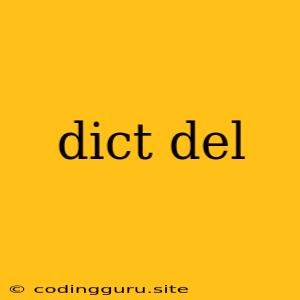Understanding and Utilizing del with Python Dictionaries
Python dictionaries are a fundamental data structure that allows you to store key-value pairs. Efficiently manipulating this data often requires understanding how to remove specific elements. The del keyword plays a crucial role in this process.
What is del?
In the context of Python, del is a powerful keyword that enables you to delete objects from memory. It's not limited to dictionaries; you can use del to remove variables, lists, tuples, and even functions. However, when working with dictionaries, del allows you to target specific key-value pairs for removal.
How to use del with dictionaries?
The basic syntax for using del with dictionaries is straightforward:
del dictionary_name[key]
Here, dictionary_name refers to the name of your dictionary, and key represents the key associated with the value you wish to delete. Let's look at an example:
my_dict = {'name': 'Alice', 'age': 30, 'city': 'New York'}
# Deleting the 'age' key-value pair
del my_dict['age']
print(my_dict)
Running this code will output:
{'name': 'Alice', 'city': 'New York'}
Why use del for dictionaries?
While other methods exist for removing elements from dictionaries, such as pop() and popitem(), del offers distinct advantages:
- Direct Removal:
deldirectly targets the key-value pair you want to remove, making it efficient and explicit. - Flexibility: You can use
delto delete multiple key-value pairs within a loop or conditional statements. - In-Place Modification:
delmodifies the dictionary directly, eliminating the need for creating a new dictionary object.
Caveats and Considerations
While del is a valuable tool, remember these points:
- Key Existence: If the key you try to delete does not exist in the dictionary,
delwill raise aKeyError. Ensure the key you specify actually exists in the dictionary before attempting deletion. - Immutability: Remember that dictionaries are mutable data structures. The changes you make using
delare permanent and affect the original dictionary object.
Practical Examples
Here are some real-world scenarios where del is particularly useful with dictionaries:
- Data Cleanup: Imagine a dictionary storing user information. If a user account is deleted, you can use
delto remove their data from the dictionary. - Conditional Removal: You might want to remove certain key-value pairs from a dictionary based on specific criteria, like deleting entries older than a certain date.
- Resource Management: Dictionaries can be used to manage resources like file handles or network connections.
delhelps in releasing those resources once they are no longer needed.
Conclusion
The del keyword provides a powerful way to delete specific key-value pairs from Python dictionaries. Understanding its usage and caveats ensures you can efficiently manipulate and maintain your dictionary data.
